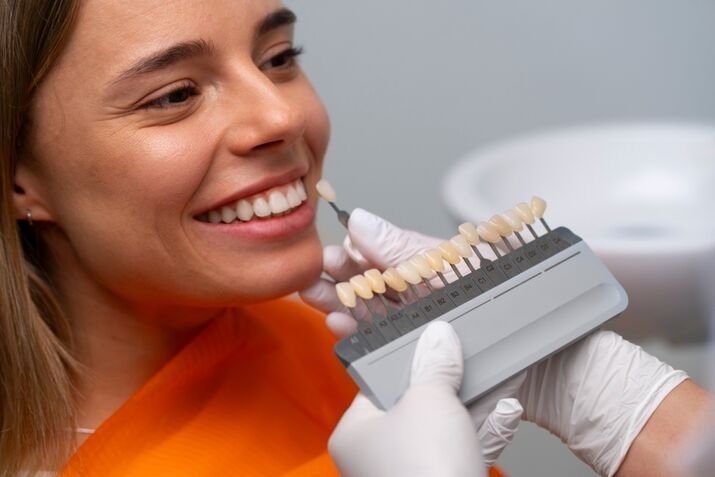Can Veneers be Removed Once They're Applied?

Understanding Veneer Removal
Thinking about taking off your dental veneers? You're in the right place! Let's chat about what it means when you're looking at getting rid of those pearly covers. Whether you're already flashing veneers or just thinking about trying them, here's what you should know about how long they stick around and why you probably shouldn't take them off yourself with a YouTube tutorial.

Veneer Longevity and Replacement
Usually, veneers like to hang on for 7 to 15 years. But like in life, stuff happens you didn't see coming—chips, cracks, or maybe your style changes. You might find yourself wanting an upgrade because they don't fit right or something's bugging your gums. Taylorview Dental points out that veneers aren't forever; reasons like a bad fit or gum grumbles might see them going sooner than planned.
What Can Cut Veneer Life Short?Why It MattersChips or CracksTime for a fix-itFunky Color ChangesSwap them outChange Your LookPick a new styleTooth Decay or Gum GripeMight need a redo
Before diving in, take a peek at the lifeline of dental veneers or check out what's awesome—and not so awesome—about getting them in the first place via benefits and drawbacks of dental veneers.
Risks of DIY Veneer Removal
Thinking, "Hey, can I just whip these off myself?" Hold that thought. Veneers coming off should only be a job for your trusty dentist. DIY veneer removal equals asking for trouble.
Getting veneers glued on means your teeth have already had a little filing down action. Rip them off at home, and you might end up with pain, tooth damage, or worse. Healthline warns that if you're not super careful, your teeth could end up as sensitive as a teenager's ego.
Plus, if they aren't sitting just right, they can make things uncomfortable, which is another reason to let the pros handle it. Consider getting schooled on your options—thinking about veneers vs. crowns: which is the better option? could save some headaches down the line.
Process of Removing Veneers
Taking off dental veneers ain't something you wanna try by yourself at home on a lazy Sunday afternoon. This job needs a pro's hand to ensure everything goes smooth and the outcome keeps your smile shining bright.
Duration and Techniques
Getting those veneers off generally falls within a 30-minute to hour-long range, give or take, depending on how many you got. A dentist, who’s been around the block a few times, can often get the job done quicker than a newbie [1].
There’s a whole toolbox needed for this gig—high-tech gadgets like rotary instruments, lasers, and some nifty dental gizmos. These contraptions help break the stubborn bond between your teeth and veneer, making it easier to ease them off [2]. Skip the attempts of DIY removal 'cause those veneers are stuck tight with robust dental cement and an amateur’s touch would spell trouble for your pearly whites [1].
StepDescription1Give the veneers the once-over to figure out the best removal game plan2Numb it up with local anesthesia for maximum chill3Equipped with special tools, they carefully peel off the veneers4Checkup on the teeth beneath—are they okay or craving some TLC?
Pain and Discomfort Considerations
Yanking off veneers ain't a pain fest, thanks to that numbing stuff, but some folks might feel a bit touchy or tender during and after the fun's over [1].
Keep in mind, if things go sideways, there’s a chance of leaving the tooth structure high and dry which can cause issues like extra sensitivity [2]. Once the veneers take a hike, you might be lining up for a new set or another kind of dental makeover.
Thinking about saying adios to your veneers? Weighing out the options is smart. Check out more details on the whole veneers biz right here.
Replacing Veneers
It's normal for veneers to eventually need replacing as they wear out or encounter other issues. Knowing when to swap them out is key to keeping that smile looking sharp.
Evaluating the Need for New Veneers
Here’s why you might need some fresh veneers:
Chatting with your dentist is step one. They’ll look at the condition of your teeth and veneers, guiding you through the decision-making process. According to Taylorview Dental, they’re the best judge of whether new veneers or a different route is your best bet.
Multi-Step Replacement Process
Swapping out veneers isn't a quick fix. The process usually includes these steps:
This multi-step gig makes sure that the new veneers look great and keep your teeth happy. If you're curious about the pros and cons of different dental options, check out the alternatives like veneers vs. crowns: which is the better option?. It's all about helping folks make smart choices for their million-dollar smile.
Veneer Alternatives
When it comes to getting that picture-perfect smile, some folks find veneers aren't their cup of tea. But don't worry, there are other options to make your pearly whites shine. Let's dive into dental bonding and crowns, or maybe it's time to give orthodontic treatments a thought.
Dental Bonding
So, what's the scoop with dental bonding? It's a snappy and wallet-friendly fix for teeth that need a little TLC, like if they're chipped or looking a bit off-color. The dentist plays artist, using a resin material to cover up trouble spots. Unlike veneers, bonding is like a gentle hug for your teeth — less of your natural tooth gets shaved down, which is a win for the less invasive crowd.
ProsConsQuicker processStains more easily than veneersEasier on the budgetNeeds a bit of pampering to stay chip-free
Here's the kicker though—bonding can stain easier than its veneer cousin. Once you leave the dentist's chair, you'll want to keep an eye on that bonding material to make sure it stays pristine [3].
Crowns and Orthodontic Treatments
Crowns? They're another way to jazz up your teeth. We're talking serious materials like metal, porcelain, or ceramic here. Crowns are often brought in for the big jobs—like replacing teeth that have seen better days or ones that can't handle a steak dinner anymore.
Material TypeDurabilityMetalCan take a beatingPorcelainEasy on the eyes but might chipCeramicNice mix of look and toughness
Crowns are tough nuts but not impossible to crack—they might get chips or breaks just like anything else. Plus, if you need a bunch of them, the dental bill can sneak up on you [3].
If your teeth are on the crooked side or have more gaps than a picket fence, then braces or Invisalign could be the ticket. They get right down to business, sorting out bigger alignment issues where veneers might not cut it. Just keep in mind, these come with heftier price tags and take a bit longer to work their magic [3].
Checking out these alternatives can give you some fresh ideas on getting to your grin goals. Take stock of what might work best for you, and don't forget: a chat with your dentist can make sure you're heading down the right track. And for those curious minds, dig into more about veneers with articles on are veneers a permanent solution for your smile? and veneers vs. crowns: which is the better option?.
Dental Veneer Types
Picking the right dental veneers is kinda like choosing the perfect outfit for your teeth's night out. You've got two main contestants in this beauty contest: porcelain veneers and the no-prep veneers. Both bring their own kind of shine to your smile.
Porcelain Veneers Information
When it comes to going all out for a stunning smile, porcelain veneers are a go-to favorite. They're like the red carpet of teeth solutions, great for long-lasting sparkle if you're dealing with stained, crooked, or chipped teeth. Made from tough, natural-looking porcelain, they’ve got your back for a smile that says, "I mean business." It's not a quick hop-in opportunity though—get ready for one or two weeks of dental playtime involving several detailed steps:
StepIs it worth it?Enamel ReshapingDentists do a little enamel trim to make space for the veneer. The name of the game here is 'go easy'. Too much trimming and you might feel like you're biting a popsicle with bare teeth. Anesthesia is your friend for this.Color SelectionYour tooth fairy dentist picks a shade that matches your natural teeth.Dental ImpressionThey mold your soon-to-be improved tooth for a perfect fit.Temporary Veneer PlacementWhile your custom fit is in the works, they’ll slap on a temporary band-aid—er, veneer.Final BondingOut with the temporary, in with the masterpiece. That forever friend gets cemented in place.
Porcelain lenses—not only are they beautifying, but they're tough cookies too. Dental tech advancements have changed the game with same-day installations, making it easier for the waiting-averse among us to snap up a stunning grin.
No-Prep Veneers and Their Benefits
If you prefer the chill approach, no-prep veneers might just be your dental jam. Less fussy than their porcelain counterparts, they skip most enamel dental gymnastics. No-prep means way less fuss—and your teeth won’t have those post-op ouchies.
Here's what they're bringing to the teeth fiesta:
BenefitDescriptionReduced SensitivityLittle to no enamel gets hacked away, so say goodbye to major teeth tantrums.Quick ApplicationThey’re speedy—less chair time, more 'show 'em off' time.Easy ReversibilityChange your mind? No problem. You can often ditch them and flash your original pearly whites again.
For those wanting an enhanced smile without major dental gymnastics, this is your laid-back ticket. Simple yet effective, no-prep veneers are like your best dental friend in an easy-going mood.
Thinking about the long haul with your new smile? Check out our article on how long do dental veneers last?.
Risks and Complications
Issues with Porcelain Veneers
Porcelain veneers are like the rock stars of cosmetic dentistry — everyone's talking about them! But before you pull the trigger, it’s wise to know what you're getting into. One of the biggies is that once you go veneers, there ain't no going back. The procedure permanently shaves off a teeny bit of your enamel. This could make your teeth more sensitive, especially when you sip on hot coffee or bite into cold ice cream, and if you slack on brushing and flossing, decay might just sneak in [4].
And guess what? If these veneers don't fit just right, you might feel like you’re walking around with a pebble in your shoe, only it's your mouth. They can mess with your bite or even your speech. If your bite gets funky, it might mess with your jaw too, leading to those dreaded TMJ issues. So, regular dentist visits and bite checks are your new best friends [4].
Let’s not forget about the gums. Veneers might irritate them, causing swelling if the fit isn’t spot on or if bacteria party around them. Feeling gum irritation? Gotta make sure you’ve got a top-notch dentist in your corner to ensure everything feels just right [4].
ComplicationsDescriptionTooth SensitivityThat enamel trim can make you wince with hot drinks or cold snacks.Gum IrritationVeneer edges might bug your gums, leading to some unwanted puffiness.Bite IssuesA wonky bite might bring jaw pain or those pesky TMJ troubles.Speech ChallengesMisfit veneers can jumble up your speech a tad.
Bioclear as an Alternative Option
Thinking there might be other fish in the sea besides porcelain veneers? Enter Bioclear. It’s the fancy new option that's catching attention for being gentler on your pearly whites. This strategy works wonders on those “black triangles” — those tiny gaps that make your smile look like it’s missing a beat. Bioclear uses super cool matrices and dental composite to close the gaps for a more complete grin [5].
Here’s the sweet part: Bioclear works its magic without demanding enamel sacrifices. It still boosts the look of your teeth but sidesteps the heavy-duty prep that veneers call for. If you’re on the fence about veneers, weigh the pros and cons of Bioclear too, and have a chat with your dentist about which suits your style better and addresses your unique needs. If you want a deeper dive into what's what, don't miss our take on benefits and drawbacks of dental veneers.
References
[2]:
[3]:
[4]:
[5]:










.jpg)


















.avif)


















.jpg)


























.jpg)























